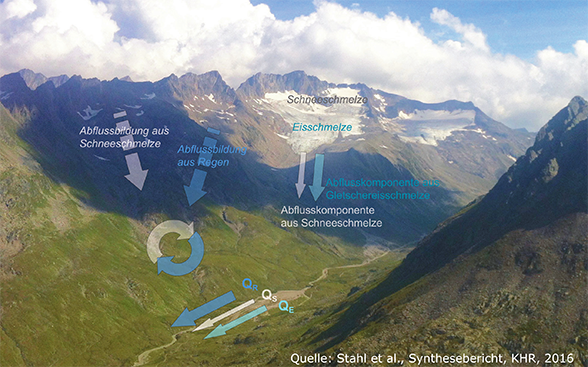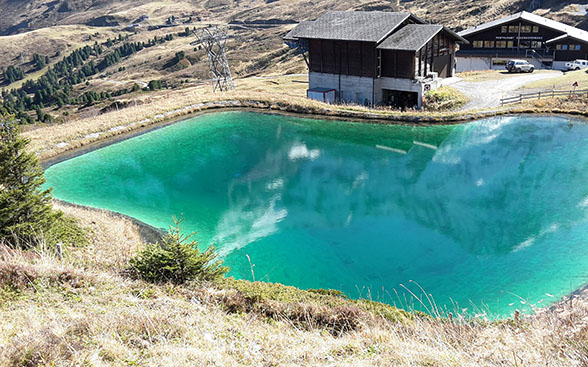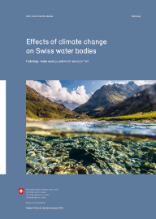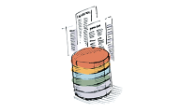One of the aims of Hydro-CH2018 is to improve understanding of the hydrological process and close some existing gaps in our knowledge of the impact of climate change on water resources in Switzerland. Various research projects have been carried out by many Swiss research institutions.
Hans-Peter Beck, Sturmarchiv Schweiz Teaser.jpg)
Projects
- Improved information on agricultural irrigation in Switzerland (SwissIrrigationInfo)
- Drought events in Switzerland – meteorological causes and compound meteorological, hydrological and agricultural drought (COM-DROUGHTS)
- Updating of the hydrological scenarios on the basis of new climate scenarios
- Runoff contribution from snow and glacier melt
- Hydrological scenarios, based on high-resolution climate data
- Forest dynamics, land use and water balance
- Impact of climate and management changes on inputs and water resources
- Water balance and drought
- Groundwater dynamics in alpine catchments
- Water storage
- Temperatures of watercourses and lakes
- Temperature development of Swiss groundwater bodies
A detailed description of the results from the research projects is published in the Hydro-CH2018 synthesis report. Information on the data is available on the data page.
Improved information on agricultural irrigation in Switzerland (SwissIrrigationInfo)
[ongoing - project completion expected in 2023]
Water resources are facing growing pressure, due in large part to the advance of climate change. The new hydrological scenarios indicate that summer runoff will decrease significantly, especially in the Swiss Plateau. Rising temperatures will likely increase need for irrigation in agriculture at the same time. It is currently difficult to assess whether these changes might lead to water-related conflicts over the long term, or where such conflicts might arise, as data on water consumption for agricultural irrigation is lacking for most cantons and also for Switzerland as a whole. This information is crucial, however, for early detection, long-term planning and avoidance of water-related conflicts, as well as for the protection of ecosystems.
The SwissIrrigationInfo project aims to fill this gap by systematically compiling data on agricultural water use from sources including cantons, communes and irrigation cooperatives. This new foundation will not only allow the study of current and past water consumption in agriculture, it can also be used with agricultural and climate scenarios to develop a tool for estimating possible future demand for water.
The results from the project will thus provide an important basis for sustainable long-term resource planning and the early detection of water-related conflicts, for example when planning irrigation projects. They will also facilitate measure AP2-w1, Collection of data on water demand in Switzerland, which is described in the second action plan on adapting to climate change (available in German, French and Italian).
Drought events in Switzerland – meteorological causes and compound meteorological, hydrological and agricultural drought (COM-DROUGHTS)
[ongoing - project completion expected in 2023]
Global warming is expected to lead to increasing drought in Switzerland. The new hydrological scenarios indicate that summer runoff will decrease significantly in the Swiss Plateau, Jura and Ticino while water consumption will increase, especially in agriculture. Drought events, such as those in 2003 and 2018, and water shortages can be expected to occur more frequently.
So far, little is known about the origin of the three types of drought (hydrological, agricultural and meteorological) or their compound events. This project therefore aims to investigate such events and to estimate their future change, based on data from the new CH2018 climate scenarios and the Hydro-CH2018 hydrological scenarios. The meteorological (pre-)conditions associated with hydrological drought will also receive special attention. This holds great potential for improving the prediction and early detection of drought.
The results will serve as a basis for adapting to the impact of climate change on drought conditions, for example through the sustainable planning of water resources. In addition, the project facilitates work on the AP1-w10 measure, Early detection of drought, from the first action plan on adapting to climate change
Updating of the hydrological scenarios on the basis of new climate scenarios
How does runoff change in different climate scenarios?
Method
In total, 93 catchments (FOEN stations) were calibrated and validated using the PREVAH-UniBE model. They cover various runoff regimes (pluvial, nival, glacial, southern alpine) and catchment sizes (10–1700 km2). Runoff time series were then computed for each catchment for different emission scenarios (RCP2.6, 4.5, 8.5) at daily intervals. The daily discharge results were analysed for different indicators on medium, high and low discharge. As the new climate scenarios are available continuously over 120 years, the timing of significant changes in runoff can also be determined for the first time.
Main results
- The timing of significant changes in runoff tends to be earlier in the higher catchments than in the Swiss Plateau
regions. - Further results are available on the NCCS web atlas and the Hydrological Atlas of Switzerland HADES (www.hydromapscc.ch).
Quantification of runoff contribution from snow and glacier melt

© Markus Weiler
What are the effects of the melting of the glaciers and the reduction in snowpack on discharge?
Method
The runoff contribution from rain, snow and glacier melt were determined for 190 glaciated headwater catchments in the Swiss Alps using the hydrological model HBV Light-UniZH. The snow and glacier modules of the model were specifically adapted to optimise the representation of snowpack and glaciers. The model was calibrated using discharge data, snowpack and glacier data. This enabled the runoff contributions to be calculated for regions without such data, as data on snowpack and glacier coverage is available nationwide.
Main results
The total glacier melt contribution of the 190 headwater catchments currently makes up 8% of annual runoff and reduces to less than 2% without climate change mitigation towards the end of the century. The contribution from snow reduces from the present 34% of annual discharge to 25% without climate change mitigation by the end of the century.
Hydrological scenarios, based on high-resolution climate data
What is the effect of the natural variability in the climate data on the hydrological scenarios?
Method
The natural variability of the atmosphere was simulated for nine CH2018 climate projections using a weather generator. Meteorological parameters with high temporal and spatial resolution (e. g. hourly precipitation data) were then calculated for the three catchments of Thur, Kleine Emme and Maggia, as can be expected under future climate conditions. On the basis of these climate data, hydrological scenarios were then computed using the hydrological model Topkapi-ETH. The results were compared with the current natural variability.
Main results
- The models show changes in annual precipitation as early as the 2020–2049 period, but the changes are only greater than the current natural variability in a scenario without climate change mitigation and at the end of the century.
- The change in heavy precipitation can vary widely over a small area and even within catchments. For the Kleine Emme and Thur, heavy precipitation increases in the lower lying areas by the end of the century, but decreases at higher elevations.
- Hourly heavy precipitation levels increase without climate change mitigation by the end of the century (median by 5% for the Thur and Kleine Emme and 20% for the Maggia). This increase, which is calculated for heavy precipitation events with both a 2-year and a 30-year return period, is not statistically significant and is within the range of natural variability.
- The changes in annual high flows are not statistically significant and are also within the current natural variability.
Forest dynamics, land use and water balance
How do future changes in forest dynamics affect evaporation and runoff?
Method
The water balance model PREVAH-WSL was coupled with a forest development model. The effects on forest development and water balance were computed for six catchment on the basis of the CH2018 climate scenarios.
Main results
- On the Swiss Plateau and in the Prealps, no major changes in discharge due to changes in forest dynamics are anticipated.
- Climate change fosters an increase in forestation in the Alps. The increase in forested areas also depends on the further development of alpine farming, as woodland cannot grow on grazed pastures.
- Increasing forestation in the Alps would have a significant influence on evaporation and discharge. In the distant future this could lead to more evaporation in alpine catchments and therefore to a reduction in annual runoff of up to 10%. Due to the increasing root depth, this effect is most marked in autumn, which would further exacerbate the climate-related minimum discharge level at that time of year.
AgriAdapt: Impact of climate and management changes on inputs and water resources
How is the irrigation requirement changing as climate change advances and what impact does this have on the water table?
Method
The impact of climate change on crops, irrigation requirements and water tables was analysed for an aquifer in the Bernese lake region using an integrated modelling system consisting of plant, hydrological and groundwater models.
Main results
- Without climate change mitigation (RCP8.5), the irrigation requirement would increase by around 40% by the end of the century, and with climate change mitigation (RCP2.6) an average increase of around 13% could be expected.
- Without climate change mitigation and with more intensive farming (+20% of crops requiring intensive irrigation), the water requirement would rise on average by a further 35%. A potential means of saving water is to increase cultivation of early ripening varieties and winter crops.
- Without climate change mitigation (RCP8.5), the estimated water requirement for irrigation would exceed the current drinking water requirement in the future.
- Without climate change mitigation (RCP8.5), a lower water table is expected in summer and autumn. This effect would be compounded by additional water abstraction for irrigation. Nevertheless, the effect of climate change on the water table is more dominant than the effects of the land use scenarios considered (+/-20% of crops requiring intensive irrigation).
Water balance and drought
How does climate change affect drought, plant physiology regulation of transpiration and future irrigation needs?
Method
Using the coupled regional climate model COSMO-CLM2, the effects of climate change on the water balance and drought periods in Europe were computed on a 50-km raster (RCP8.5). Particular attention was paid to future irrigation needs and plant physiology adaptations to the higher CO2 levels. The model chains from CH2018 were also analysed in more detail in terms of future drought.
Main results
- Without climate change mitigation, longer periods of drought, loss of soil moisture and a reduction in runoff are expected in Switzerland in future. The precise degree of dehydration in summer is still uncertain.
- Assuming an unchanging agricultural land use area, the irrigation needs for the crops currently cultivated will double due to climate change by the end of the century.
- Some plants react to higher CO2 levels by closing the pores on their surface (stomata), which reduces water loss. This leads to a general reduction in evapotranspiration, which could further exacerbate the rise in air temperature and extreme temperatures in many parts of Central and Northern Europe.
- Although the global climate models address this plant physiology effect, it is lacking in the regional climate projections used for the CH2018 climate scenarios. If the process is included, the projected maximum temperature in summer increases even further compared with CH2018.
Groundwater dynamics and storage in alpine catchments
How do the groundwater resources in alpine catchments alter with climate change and how does this influence runoff formation?
Method
The relationship between the groundwater and runoff dynamics was analysed for 11 alpine catchments. Measured data and geological information were integrated in physically based models. These simulations can quantify the influence of climate change on the groundwater resource and the reaction of the catchments.
Main results
- Alpine groundwater resources in unconsolidated and consolidated rock react differently to climate change. The main change in unconsolidated rock is the seasonal dynamics, but over the year as a whole the amount remains the same. Unlike locations on the Swiss Plateau, the seasonal groundwater dynamics are reduced in the alpine unconsolidated rock.
- Long-term decreasing trends in stored groundwater can also be seen in the alpine consolidated rock. Despite the earlier snow melt and higher evapotranspiration in summer, the groundwater reserves and recharge rate in alpine regions remains much higher in summer than in winter. Extensive deposits of unconsolidated rock have a balancing effect on discharge, because they can store and then release large amounts of groundwater according to the season.
Water storage

Can natural lakes and artificial reservoirs help to alleviate summer water scarcity?
Method
Using the hydrological model PREVAH-WSL, hydrological scenarios for the whole of Switzerland were computed using eight climate model chains with climate change mitigation (RCP2.6) and 18 without (RCP8.5). Based on the results, the changes in the total water availability in Switzerland were determined. The future water needs were also estimated on the basis of the hydrological scenarios.
Main results
- In the case of artificial reservoirs, virtually the entire storage capacity is actually usable, but in most cases is currently reserved for hydropower production. In the case of the natural lakes, only a small part is sustainably usable, because the water level must not fall below a minimum. Minimum outflows to the downstream waters must be met in all the lakes.
- Summer water shortages can be expected, mainly on the Swiss Plateau and to some extent in alpine regions. The artificial reservoirs are mainly located in the Alps, far away from the regions with potential water scarcity. This makes the possible contribution of alpine reservoirs to reducing summer water scarcity on the Plateau quite small. Local reservoirs would have greater potential, but space for these is generally lacking in that region.
Effect of climate change on the temperatures of watercourses and lakes
How will the water temperatures of the Swiss watercourses and lakes develop in future?
Method
Using the models Snowpack/Alpine3D and StreamFlow, temperature scenarios were modelled for six watercourses on the Swiss Swiss Plateau (Birs, Broye, Eulach Ergolz, Rietholzbach and Suze) and four in the Alps (Inn, Kander, Landwasser, Lonza), as examples. Due to the long computing times, only seven RCP8.5 and four RCP2.6 climate projections could be considered for a shorter reference period (1990–2000) and two ten-year periods in the future (2055–2065 and 2080–2090).
The temperatures and mixing processes in 29 lakes were computed using the one-dimensional physical lake model Simstrat continuously for the years 1981 to 2099 for the three scenarios with climate change mitigation (RCP2.6), with medium climate change mitigation (RCP4.5) and without climate change mitigation (RCP8.5). The selected lakes cover the elevation range from 200 to 1800 MASL and volumes from 0.004 to 89 km3.
Temperature development of Swiss unconsolidated rock groundwater bodies
What are the main factors driving the temperature development of groundwater resources and how will the groundwater temperature develop in future?
Method
For 35 aquifers in five regions of Switzerland (Basel-Stadt, Basel-Landschaft, Biel, Winterthur and Davos), the impact of climate change on groundwater recharge and temperature was studied in detail and key representative parameters were obtained (e. g. aquifer geometry, storage characteristics and groundwater recharge rates and retention times). Firstly, groundwater resources in urban areas were simulated in 3D heat transport models with high temporal and spatial resolution. Secondly, and in collaboration with the EPFL using the Alpine3D model, precipitation and flow development and the change in temperature were evaluated for the three emission scenarios – with climate change mitigation (RCP2.6), with medium climate change mitigation (RCP4.5) and without climate change mitigation (RCP8.5) – for the 35 aquifers. The analyses enabled to define the sensitivity of groundwater temperatures in connection with the basic groundwater recharge processes for different future emission scenarios.
Main results
- The impact on groundwater temperatures is associated mainly with seasonal shifts in its recharge. For instance, a shift in precipitation and flood events from the summer to the winter months results in an increase in groundwater recharge at comparatively ‘cool’ times of the year.
- In urban and shallow groundwater resources with a shallow water table such as in Davos, groundwater temperatures are expected to suffer a greater impact. In contrast, changes in the temperature of groundwater resources which are deep, such as in Biel, or where the water table is very deep, such as Winterthur, are expected to be less pronounced and to occur over long observation periods.
Last modification 16.03.2021








